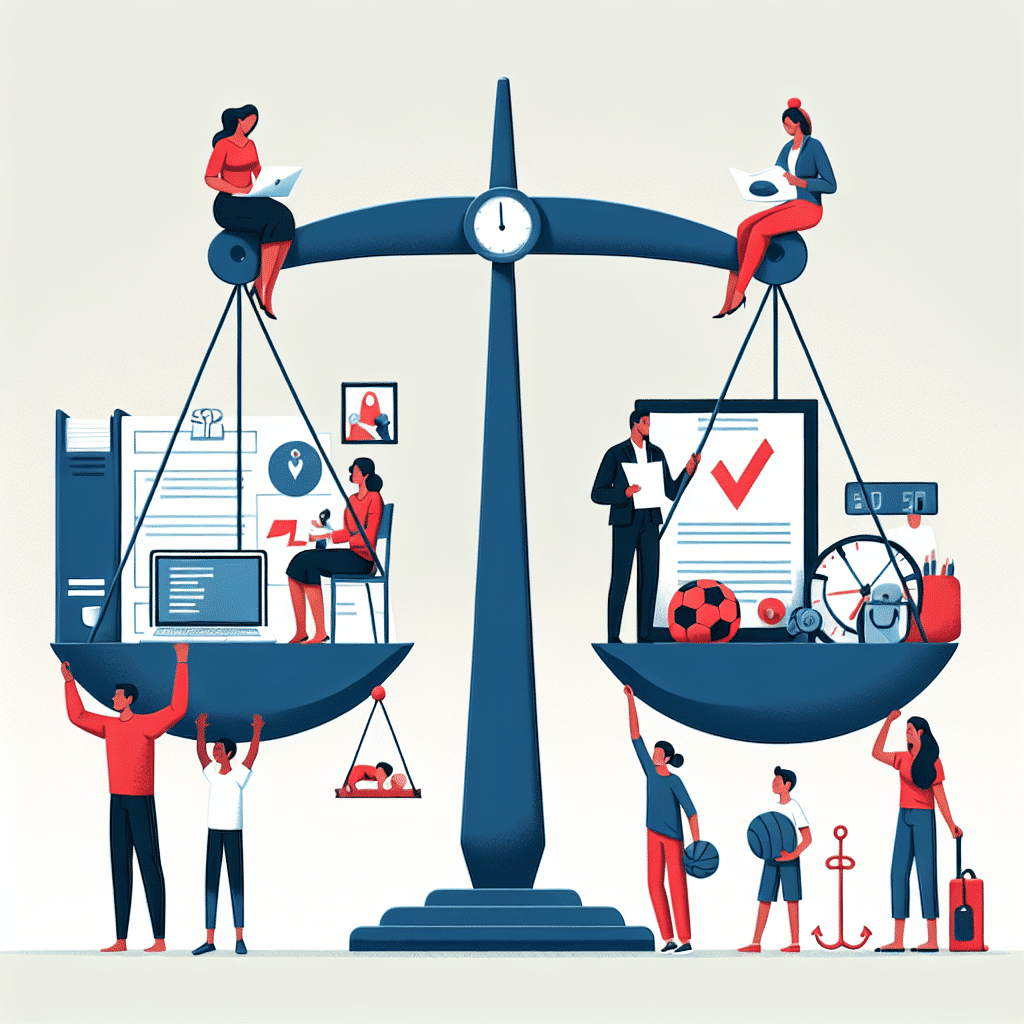
Redefining Work-Life Balance: Embracing a New Normal
In today’s fast-paced world, achieving work-life balance has become increasingly complex. However, it’s essential to redefine our understanding of balance and adapt to the new norms of the modern workplace. In this blog post, we explore practical strategies to redefine work-life balance, prioritize our well-being, and find harmony between our personal and professional lives. By rethinking priorities, fostering connections, mastering time management, and adjusting to virtual work, we can create a more fulfilling and balanced life. Join us on this journey as we redefine work-life balance and navigate the ever-evolving landscape of our professional and personal aspirations.
Defining New Norms
The traditional concept of work-life balance no longer aligns with the realities of the modern world. The boundaries between work and personal life have become increasingly blurred, demanding a fresh perspective on balance. Here are key points to consider:
1. Flexibility and Integration:
Rather than striving for a perfect balance between work and personal life, aim for flexibility and integration. Embrace the idea that different aspects of your life can coexist harmoniously, allowing for a more fluid and adaptable approach.
2. Work-Home Synergy:
View work and personal life as complementary rather than opposing forces. Recognize how experiences and skills gained from one domain can enhance the other. Seek opportunities for synergy where your personal values and aspirations align with your professional pursuits.
3. Boundaries and Separation:
While integration is necessary, establishing boundaries is equally important. Set clear boundaries between work and personal life to prevent one from encroaching on the other. Define dedicated time for personal activities, self-care, and quality time with loved ones.
4. Individualized Balance:
Remember that work-life balance is a personal journey. What works for one person may not work for another. Strive for a balance that aligns with your values, priorities, and circumstances. Regularly reassess your needs and make adjustments accordingly.
5. Mindful Technology Use:
Technology plays a significant role in our lives but can also blur the boundaries between work and personal time. Practice mindfulness in your technology use by setting boundaries, managing notifications, and scheduling dedicated “unplugged” time to foster present-moment awareness and reduce distraction.
Redefining work-life balance involves embracing new norms that promote flexibility, integration, and individualized approaches. By establishing boundaries, cultivating synergy, and mindfully managing technology, we can navigate the complexities of the modern workforce while prioritizing our well-being and achieving a sustainable work-life blend.
Re-Thinking Priorities
In redefining work-life balance, it’s essential to re-evaluate and realign our priorities. Consider the following factors to help you prioritize effectively:
1. Core Values and Purpose:
Reflect on your core values and what truly matters to you. Identify your long-term goals, aspirations, and what brings you fulfillment. By understanding your purpose, you can make decisions that align with your values and contribute to a sense of purpose in both work and personal life.
2. Essentialism and Focus:
Embrace the concept of essentialism, focusing on what truly matters and letting go of non-essential tasks or obligations. Understand that you can’t do everything, and by prioritizing your time and energy, you can direct them towards activities that have the greatest impact and bring you the most joy.
3. Boundaries and Saying “No”:
Setting boundaries is crucial in redefining work-life balance. Learn to say “no” to tasks, projects, or commitments that do not align with your priorities. Practice assertiveness and communicate your boundaries effectively, both at work and in your personal life.
4. Work-Life Integration:
Strive for work-life integration by finding ways to incorporate personal interests and values into your professional pursuits. Seek opportunities for growth, learning, and meaningful connections within your work environment. Look for workplaces that have a culture that supports work-life integration.
5. Self-Care and Well-Being:
Recognize that self-care and well-being are essential components of achieving work-life balance. Prioritize activities that promote physical, mental, and emotional health. This includes regular exercise, quality sleep, nutritious eating, and mental health practices such as meditation, mindfulness, and seeking support when needed.
By rethinking priorities, focusing on what truly matters, setting boundaries, and nurturing your well-being, you can create a work-life balance that enhances your overall quality of life and promotes success and contentment in all areas.

Fostering Connections
Fostering meaningful connections in both work and personal life is essential for redefining work-life balance. Consider the following to cultivate and maintain connections:
1. Nurture Relationships:
Invest time and effort in nurturing relationships with colleagues, family, and friends. Cultivate open communication, empathy, and understanding. Actively listen and show interest in others, fostering a sense of connection and closeness.
2. Supportive Work Environment:
Seek or create a supportive work environment that values work-life balance and promotes positive interactions. Encourage collaboration, teamwork, and a culture that respects individuals’ personal lives and well-being.
3. Establish Boundaries:
Set boundaries in both work and personal relationships to ensure a healthy balance. Clearly communicate your availability and expectations, focusing on designated work and non-work hours, and be respectful of others’ boundaries as well.
4. Quality Time:
Allocate quality time for loved ones, friends, and yourself. Be present and fully engaged during these moments, allowing for meaningful connections and the nurturing of these essential relationships.
5. Networking and Community Involvement:
Engage in networking opportunities and community involvement to expand your connections beyond the workplace. Participating in professional organizations, attending relevant events, or volunteering can foster new relationships and provide a sense of fulfillment outside of work.
Nurturing connections is an integral part of work-life balance. By fostering relationships, creating supportive environments, setting boundaries, and allocating quality time, you can cultivate a network of support and meaningful connections that contribute positively to your overall well-being.
Tackling Time Management
Effective time management is key to achieving work-life balance. Consider the following strategies to help you make the most of your time:
1. Prioritize and Delegate:
Identify your most important tasks and prioritize them based on their urgency and impact. Delegate tasks when possible to lighten your workload and free up time for essential activities.
2. Set Realistic Goals:
Set realistic and achievable goals, both short-term and long-term. Break larger tasks into smaller, manageable ones, and allocate specific time blocks to work on each task. This helps you stay organized and focused.
3. Time Blocking:
Implement time blocking to allocate specific time periods for different activities. This technique allows you to dedicate uninterrupted time to work tasks, personal activities, self-care, and family time.
4. Minimize Procrastination:
Be aware of your procrastination habits and take active steps to minimize them. Identify the underlying causes of your procrastination and employ strategies such as breaking tasks into smaller parts, using timers or productivity apps, and practicing self-discipline.
5. Balance Workload:
Balance your workload by establishing boundaries and saying “no” to excessive responsibilities. This ensures you have enough time and energy to focus on both work and personal life, reducing the risk of burnout.
6. Flexibility and Adaptability:
Embrace flexibility and adaptability in your schedule. Unexpected events and last-minute changes are inevitable, so learn to adjust your plans and be resilient in the face of unforeseen circumstances.
By implementing effective time management strategies, you can optimize your productivity, reduce stress, and create a greater sense of balance between work and personal life.
Adjusting to Virtual Work
With the increase in remote work opportunities, adjusting to virtual work is crucial for achieving work-life balance. Consider the following strategies when adapting to virtual work:
1. Establish a Dedicated Workspace:
Create a designated workspace that separates work from personal life. Having a dedicated area helps mentally and physically switch between work and non-work activities.
2. Set Clear Boundaries:
Set clear boundaries between work and personal time, and communicate these boundaries with your colleagues and family. Establish specific work hours and schedule breaks to maintain a healthy balance.
3. Maintain a Routine:
Stick to a routine and structure your day to include regular working hours, meal breaks, exercise, and leisure activities. A consistent routine helps create predictability and balance.
4. Embrace Technology:
Use technology to your advantage for effective communication, collaboration, and time management. Explore productivity tools, project management software, and virtual meeting platforms to maintain productivity and enhance work-life integration.
5. Practice Self-Care:
Take care of your physical and mental well-being by prioritizing self-care activities. Engage in regular exercise, maintain a healthy diet, practice mindfulness or meditation, and allocate time for hobbies and relaxation.
6. Communicate and Seek Support:
Maintain open and honest communication with your colleagues, supervisors, and loved ones. Express your needs and difficulties, and seek support when necessary. Remember, you are not alone in navigating the challenges of virtual work.
By adjusting to virtual work, setting boundaries, and incorporating self-care practices, you can thrive in this new work environment and achieve a healthy work-life balance.

Embracing a New Paradigm of Work-Life Balance
Redefining work-life balance is an ongoing journey that requires adapting to changing circumstances, reevaluating priorities, and embracing new strategies. By understanding the importance of flexible norms, rethinking priorities, fostering connections, mastering time management, adjusting to virtual work, and practicing self-care, you can achieve a more harmonious and fulfilling work-life blend.
Remember, work-life balance is unique to each individual, and there is no one-size-fits-all approach. It’s about finding what works best for you and continually reassessing and readjusting as needed. With conscious efforts and a commitment to your own well-being, you can create a more sustainable and satisfying balance between work and personal life, leading to greater overall happiness and success.






